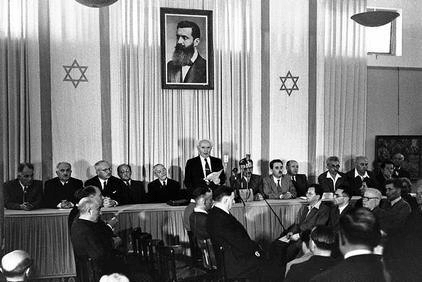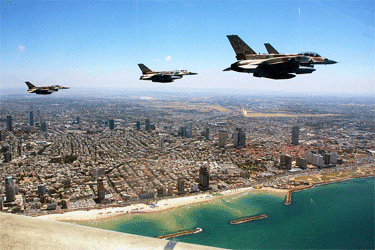Yom Ha'atzmaut - Israeli Independence Day
Held on the fifth day of the Hebrew calendar month of Iyar, Yom Ha’atzmaut is a modern holiday celebrating Israel’s independence in 1948. Israeli Independence Day is always immediately preceded by Yom Hazikaron - Memorial Day for the Fallen Israeli Soldiers. The message of linking these two days is clear: Israelis owe their independence -the very existence of the state - to the soldiers who sacrificed their lives for it.
 PM Ben-Gurion Announces Israel’s independence in 1948 |
The official “switch” from Yom HaZikaron to Yom Ha’atzmaut takes place a few minutes after sundown, with a ceremony at Jerusalem’s Mount Herzl military cemetery in which the national flag is raised from half-staff to the top of the pole. Usually, the president of Israel will deliver a speech of congratulations while soldiers representing all the various branches and units of the Israel Defense Forces parade with their flags. In recent decades this smaller-scale ceremony has replaced a much larger daytime parade which was the main event during the 1950s and ‘60s. The evening parade is followed by a torch lighting (hadlakat masuot) ceremony, symbolically marking the country’s achievements in all spheres of life.
Other than the official ceremonies, Israelis celebrate Yom Ha’atzmaut in a variety of ways. In the major cities such as Jerusalem and Tel Aviv, nighttime festivities are focused on the main streets where crowds gather to watch public shows offered for free by the municipalities and the government. In rural communities, many people spend the night dancing Israeli folk dances or singing Israeli songs. During the daytime thousands of Israeli families go out on hikes and picnics. Many army bases are also opened for civilians to visit to display the achievements of the Israeli Defense Forces. Yom Ha’atzmaut is concluded with the ceremony of granting the “Israel Prize“ recognizing individual Israelis for their unique contribution to the country’s culture, science, arts, and the humanities.
The religious character of Yom Ha’atzmaut is still in the process of formation, and is subject to debate. The Chief Rabbinate of the State has decided that this day should be marked with a recitation of Hallel (Psalms of Praise), similar to other joyous Jewish holidays, and with the reading of a special haftarah (prophetic portion). Most ultra-Orthodox Jews, in Israel and abroad, have not accepted this ruling, and some Orthodox Jews chant the Hallel without the blessing which precedes it.
 Israeli Air Force jets fly over Israel on Yom Ha'atzmaut 2011 |
On the other hand, HaKibbutz HaDati (Modern Orthodox Kibbutz Movement) initiated a version of the prayer Al HaNissim (“Concerning the Miracles”) to be added to the Amidah (the central prayer recited while standing) on Yom Ha’atzmaut, as it is on Hanukkah and Purim. This special addition to the liturgy of the day was not approved by the Chief Rabbinate but was adopted by the Masorti (Conservative) and the Progressive (Reform) congregations in Israel. Some rabbis argue that Yom Ha’atzmaut should be viewed in conjunction with Hanukkah and Purim, since all three commemorate a “miraculous” victory of the Jews over an enemy of superior military might. It should be noted that most Israelis do not consider Yom Ha’atzmaut a religious holiday at all.
Aside from Israel, most Jewish communities around the world have also incorporated Yom Ha’atzmaut into their calendars, though it has become customary from some to hold the public celebrations on the closest Sunday in order to attract more participation. In Israel it is a formal holiday; so almost everyone has the day off.
For American Jews, celebrating Yom Ha’atzmaut has been a way to express solidarity with the State of Israel and to strengthen their alliance with it. In many communities, it is one of few occasions in which Jewish organizations and synagogues of different ideologies and denominations cooperate in forming a common celebration. In many North American congregations, the joint public celebration often is augmented by a religious service. In some cases, this would occur on the Shabbat closest to Yom Ha’atzmaut and would consist of additional readings added to the service and, usually, the singing of Hatikvah (the Israeli national anthem).
There is not yet an accepted “tradition” of how to celebrate this holiday, and only time will tell whether certain customs, foods, prayers, and melodies will be linked in the Jewish mind with this holiday, as with holidays that emerged many centuries before Yom Ha’atzmaut. For Jews around the world, joining with Israelis celebrating Yom Ha’atzmaut has become a concrete link in the Jewish connection to the land of Israel.
| President Shimon Peres (2012) | Prime Minister Benjamin Netanyahu (2013) |
Sources: Some Information on this page used with permission from My Jewish Learning.


